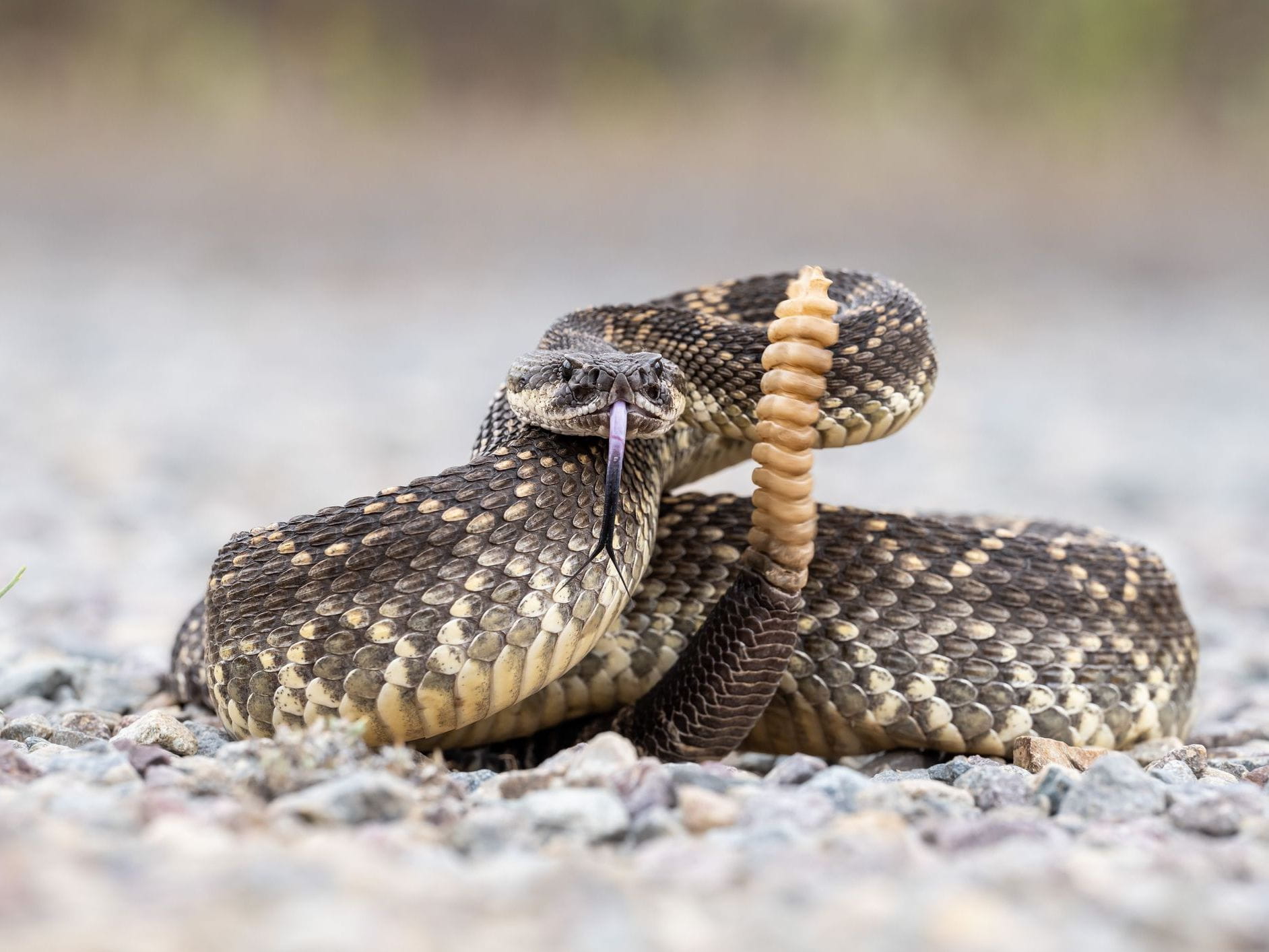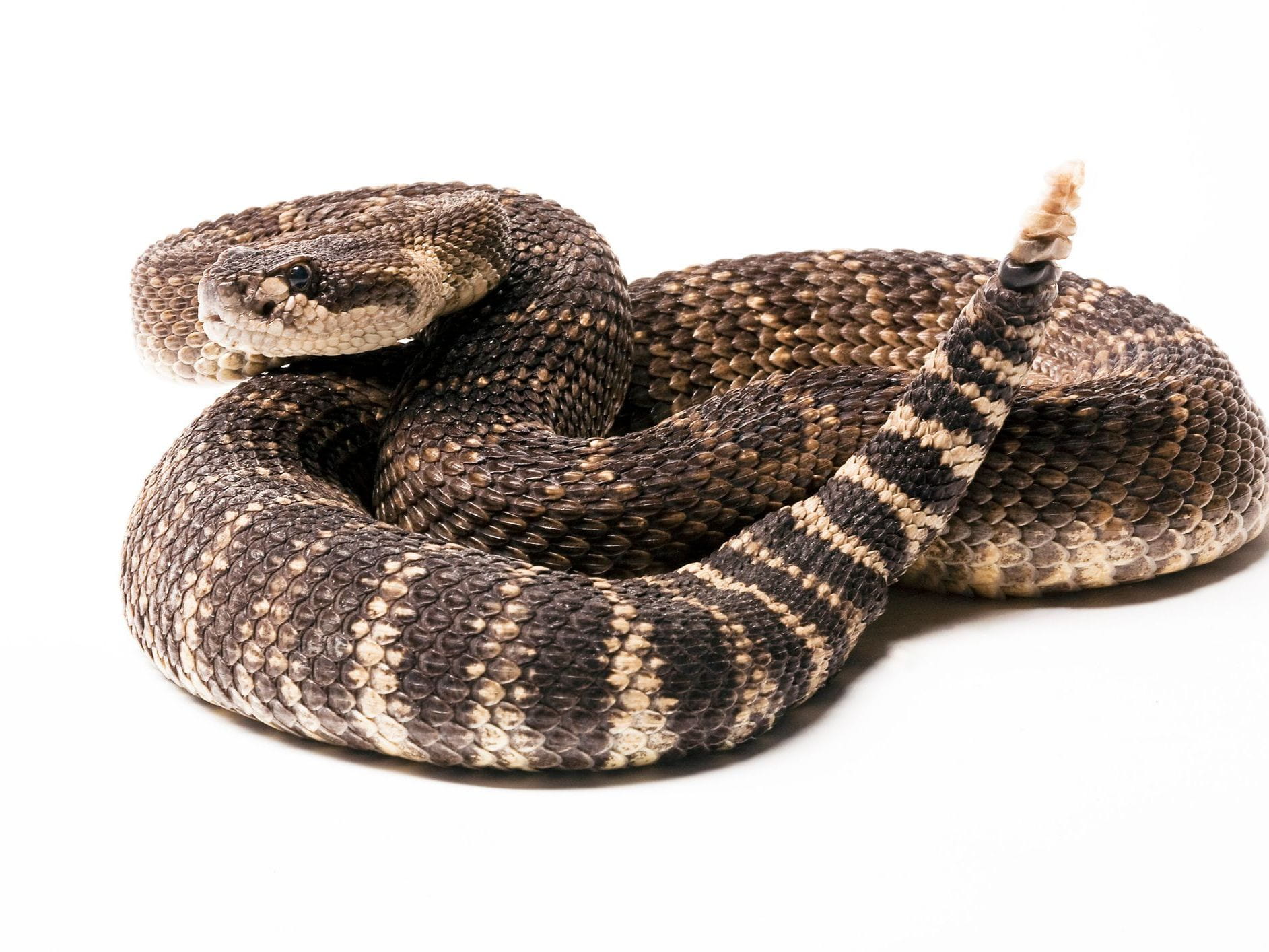Rattlesnake Bites: What You Need to Know

The Bottom Line
Rattlesnakes are a type of venomous pit viper found in many areas of the US. The most common symptoms of a rattlesnake bite are pain and swelling of the affected area, but more severe symptoms, such as bleeding and muscle weakness, can occur. Many rattlesnake bites require hospitalization and treatment with antivenom.

What do rattlesnakes look like and where do they live?
Rattlesnakes are venomous pit vipers that are found in many areas of the US. They are found as far north as New England and Washington state, and their range extends across most of the country. There are several species of rattlesnake found in the US and the type varies by region. Rattlesnakes may also be found in zoos and as exotic pets outside of their usual geographic range.
Common species of rattlesnakes found in the US include the timber rattlesnake, Mojave rattlesnake, pigmy rattlesnake, Northern Pacific rattlesnake, and the Eastern and Western diamondback rattlesnakes.
How to identify a rattlesnake.
Rattlesnakes vary in size depending on the age and species. They can range from 1 to 8 feet in length, with the majority snakes being somewhere between 2 and 5 feet long. The Eastern diamondback rattlesnake is the largest venomous snake found in the US.
The scale pattern of the rattlesnake varies by species. For example, timber rattlesnakes have a chevron scale pattern, whereas diamondbacks have a diamond-shaped scale pattern. Rattlesnakes have larger fangs than other venomous species of snakes, which can penetrate and inject venom deep into muscle tissue. Their heads are triangular in shape and feature heat-sensing pits that look like nostrils. Their pupils are elliptical in shape.
As their name implies, rattlesnakes have rattles, but they may be less obvious than you think. Younger snakes will have fewer rattles, as they accumulate rattles with the process of shedding. The snake’s rattle may also wear down or break off over time. While rattlesnakes often use their rattle as a warning when they feel threatened, they might also be silent.
Are rattlesnakes venomous?
Rattlesnakes are the most venomous domestic snakes in the US, but the symptoms will vary depending on the species and the amount of venom injected. Most bites require hospitalization and treatment with antivenom. However, deaths from rattlesnake bites are extremely rare. Some bites are “dry bites,” meaning that the snake does not inject any venom and symptoms are milder, usually limited to some localized pain around the site of the bite.
What are the symptoms of a rattlesnake bite?
The most common symptoms of a rattlesnake envenomation are pain and swelling around the bite site that can progress, sometimes causing severe tissue damage. Other symptoms will depend on the species of snake involved. Some species can affect the ability of the blood to clot, causing bleeding. Other rattlesnakes, like coral snakes, have a neurotoxin in their venom, which can lead to nerve and muscle weakness and paralysis. This can be very serious when respiratory muscles are affected.
Is there a treatment for rattlesnake bites?
There is an antivenom available for rattlesnake bites, which should be administered to patients with significant pain, swelling, problems with blood clotting (coagulopathy), or neurologic symptoms. In addition to antivenom, patients will need pain medications, an updated tetanus shot, and wound care. Rarely, muscle weakness can affect the respiratory muscles and respiratory support with a ventilator may be required.
Antivenom slows or halts the swelling but does not reverse it, and swelling and tissue damage might take weeks to resolve. Other symptoms such as coagulopathy can also take days or weeks to resolve. Dry bites and mild envenomations often require only simple wound care and pain control.
What should I do if I’ve been bitten by a rattlesnake?
If someone is bitten by a rattlesnake:
- Do seek immediate medical attention.
- Don’t panic. Snakebites can be treated and are generally less dangerous than many people assume.
- Don’t risk another bite by trying to capture or kill the snake. If you can take a picture or describe the snake to a Poison Control or medical expert, that's helpful, but not essential.
- Don’t use outdated first aid remedies: no tourniquets, ice, or cutting the wound and sucking out the venom. None of these "treatments" help and most of them make things worse.
- Do keep the victim quiet and still.
- Do keep the arm or leg (usual sites for snakebite) at the level of the heart.
- Do remove any jewelry, watches, or tight clothing from the bite area.
- Do wash the area gently with soap and water.
If someone is bitten by a rattlesnake, help from experts is available by phone at 1-800-222-1222. Poison Control’s expert guidance is always free, confidential, and available 24 hours a day. Local experts in treating snakebites are also available. They can help you figure out if the bite is from a venomous or non-venomous snake. They will tell you what to do next based on the information available and your symptoms.
Maryann Amirshahi, PharmD, MD, MPH, PhD
Medical Toxicologist
Poison Control Media Information
Did you find this page helpful? If so, we need your support. Poison Control is in constant competition with misinformation online. Links to www.poison.org or our webPOISONCONTROL triage tool from other websites and blogs help internet searchers quickly find accurate information and Poison Control’s contact information in an emergency. If you use the content from this page, please provide attribution via a link back to this page, www.poison.org, or https://triage.webpoisoncontrol.org/#!/exclusions. By doing so, you could save a life. Thank you!
Poisoned?
Call 1-800-222-1222 or
Prevention Tips
- Remember that rattlesnakes would rather leave you alone. Walk away and do not provoke them.
- Pay attention to your surroundings, particularly if you hear a warning rattle.
- Watch where you walk and look before you reach or grab something hidden. Stay on trails when hiking. Turn on the lights at home or use a flashlight if it's dark.
- Wear shoes when you go outdoors, as bites commonly occur in people walking barefoot.
- Even a dead snake can envenomate. Do not try to handle a dead snake.
This Really Happened
Case 1. A 27-year-old woman was bitten on the ankle by a rattlesnake in the mountains of West Virginia. She presented to the hospital immediately and antivenom was promptly administered. She had significant leg swelling and bruising past the knee. She completed a full course of antivenom and was discharged after 3 days in the hospital. She went on to make a full recovery, but had pain and swelling of the extremity for 2 weeks.
Case 2. A woman in her 50s was bitten by a prairie rattlesnake in South Dakota. She had severe pain and swelling in her foot initially, which progressed up her leg, causing significant tissue damage. She also had low platelet counts due to the effects of the venom on her blood. She was treated with pain medication and antivenom and was in the hospital for over a week. Her swelling persisted for a couple of weeks after discharge, but she eventually made a full recovery.
Case 3. A 60-year-old man was bitten on the ankle by an Eastern diamondback rattlesnake. An x-ray was performed and his tetanus vaccine was updated. He was monitored for 12 hours and only had mild pain and minimal swelling. He was discharged home with a presumed dry bite.
For More Information
Venomous snake bites: Symptoms & first aid. Centers for Disease Control and Prevention. June 28, 2021. Accessed August 19, 2024. https://www.cdc.gov/niosh/topics/snakes/symptoms.html.
Snake Safety. USDA Accessed August 19, 2024. https://www.fs.usda.gov/Internet/FSE_DOCUMENTS/stelprdb5393596.pdf
Snakebites - snakebites. Merck Manual Consumer Version. Accessed August 19, 2024. https://www.merckmanuals.com/home/injuries-and-poisoning/bites-and-stings/snakebites.
References
Lavonas EJ, Ruha AM, Banner W, Bebarta V, Bernstein JN, Bush SP, Kerns WP, Richardson WH, Seifert SA, Tanen DA, Curry SC, Dart RC., Rocky Mountain Poison and Drug Center, Denver Health and Hospital Authority. Unified treatment algorithm for the management of crotaline snakebite in the United States: results of an evidence-informed consensus workshop. BMC Emerg Med. 2011 Feb 03;11:2.
Nakamura H, Maciulewicz T, Ramirez J, Hughes B, Axon DR, Shirazi F, Smelski G. Twenty-five years of suspected rattlesnake encounters in Arizona. Clin Toxicol (Phila). 2024 Jul 25:1-7.
Patel V, Kong EL, Hamilton RJ. Rattle Snake Toxicity. [Updated 2023 Jul 28]. In: StatPearls [Internet]. Treasure Island (FL): StatPearls Publishing; 2024 Jan-. Available from: https://www.ncbi.nlm.nih.gov/books/NBK431065/
Yu E, Altschuh L. Clinical Management of North American Snake and Marine Envenomations. Emerg Med Clin North Am. 2024 Aug;42(3):653-666.
Poisoned?
Call 1-800-222-1222 or
Prevention Tips
- Remember that rattlesnakes would rather leave you alone. Walk away and do not provoke them.
- Pay attention to your surroundings, particularly if you hear a warning rattle.
- Watch where you walk and look before you reach or grab something hidden. Stay on trails when hiking. Turn on the lights at home or use a flashlight if it's dark.
- Wear shoes when you go outdoors, as bites commonly occur in people walking barefoot.
- Even a dead snake can envenomate. Do not try to handle a dead snake.
This Really Happened
Case 1. A 27-year-old woman was bitten on the ankle by a rattlesnake in the mountains of West Virginia. She presented to the hospital immediately and antivenom was promptly administered. She had significant leg swelling and bruising past the knee. She completed a full course of antivenom and was discharged after 3 days in the hospital. She went on to make a full recovery, but had pain and swelling of the extremity for 2 weeks.
Case 2. A woman in her 50s was bitten by a prairie rattlesnake in South Dakota. She had severe pain and swelling in her foot initially, which progressed up her leg, causing significant tissue damage. She also had low platelet counts due to the effects of the venom on her blood. She was treated with pain medication and antivenom and was in the hospital for over a week. Her swelling persisted for a couple of weeks after discharge, but she eventually made a full recovery.
Case 3. A 60-year-old man was bitten on the ankle by an Eastern diamondback rattlesnake. An x-ray was performed and his tetanus vaccine was updated. He was monitored for 12 hours and only had mild pain and minimal swelling. He was discharged home with a presumed dry bite.
